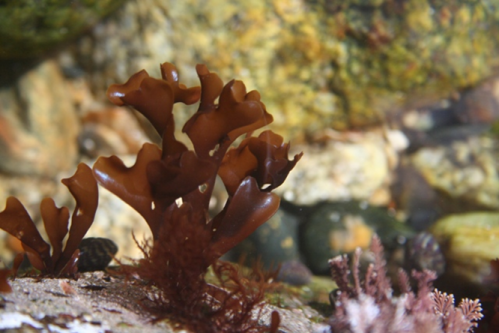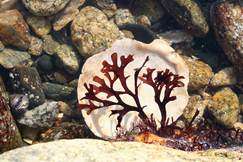Why red algae never colonized dry land

The first red alga genome has just been sequenced by an international team coordinated by CNRS and UPMC at the Station Biologique de Roscoff (Brittany), notably involving researchers from CEA-Genoscope, the universities of Lille 1 and Rennes 1 and the Muséum National d'Histoire Naturelle. The genome of Chondrus crispus, also known by the Breton name 'pioka', turns out to be small and compact for a multicellular organism. It has fewer genes than several other species of unicellular algae, which raises a number of questions about the evolution of red algae. This low number of genes could explain why these organisms never colonized dry land, unlike their green counterparts-from which all terrestrial plants are descended. These findings open up new perspectives on the natural history of algae and of terrestrial plants. They are published online in the journal PNAS on March 11, 2013.
Chondrus crispus is a multicellular red alga of about 20 cm in length. It is very common on the rocky coasts of the North Atlantic where it plays an essential role as a primary producer in these ecosystems. Certain red algae are now used in the agri-food industry for the thickening properties of the carrageenans from their cell walls. These sulfated polysaccharides correspond to the food additive E-407, which goes into many desserts and other dishes. Beyond industrial applications, this first sequencing of a red alga genome sheds new light on plant evolution as a whole.

The Chondrus genome had some surprises in store for the researchers. With only 9,606 genes and 105 million base pairs, it is indeed very small for a multicellular organism. By way of comparison, the unicellular green alga Chlamydomonas reinhardtii has 14,516 genes, while the multicellular terrestrial plant Arabadopsis thaliana has 27,416. The Chondrus genome is also very compact, with each function generally corresponding to a single gene. Gene families are small, and genes closely spaced.
To explain these surprising characteristics, the researchers proposed the hypothesis that, more than a billion years ago, red algae experienced a massive loss of genetic material as a result of extreme environmental conditions. This dramatic event in their evolutionary history would have had many consequences. One result could be the loss of flagellar genes, still present in most other organisms and responsible for the motility of certain cells (such as the gametes during sexual reproduction in most organisms, including humans).
Had this massive gene loss never occurred, red algae might have extensively colonized the terrestrial environment, in the same way as green algae, which are the ancestors of all land plants. Yet this event-a real evolutionary bottleneck-has denied red algae the plasticity and genetic potential necessary to adapt to life on land.
The sequence of the Chondrus genome thus opens the archives of more than 1,500 million years of evolutionary history of terrestrial and marine plants. It provides a new basis for the study of red algae biology and is the first step in a program aiming to improve our understanding of the origin of life on Earth, the adaptation of red algae to their environment and the biosynthesis pathways of biomolecules of interest, such as carrageenans. The scientists of the group are also hoping to discover new enzymes of interest for marine biotechnology.
More information: Collen, J. et al. Genome structure and metabolic features in the red seaweed Chondrus crispus shed light on evolution of the Archaeplastida, PNAS. Available online March 11, 2013.
Journal information: Proceedings of the National Academy of Sciences
Provided by CNRS











.jpg)






